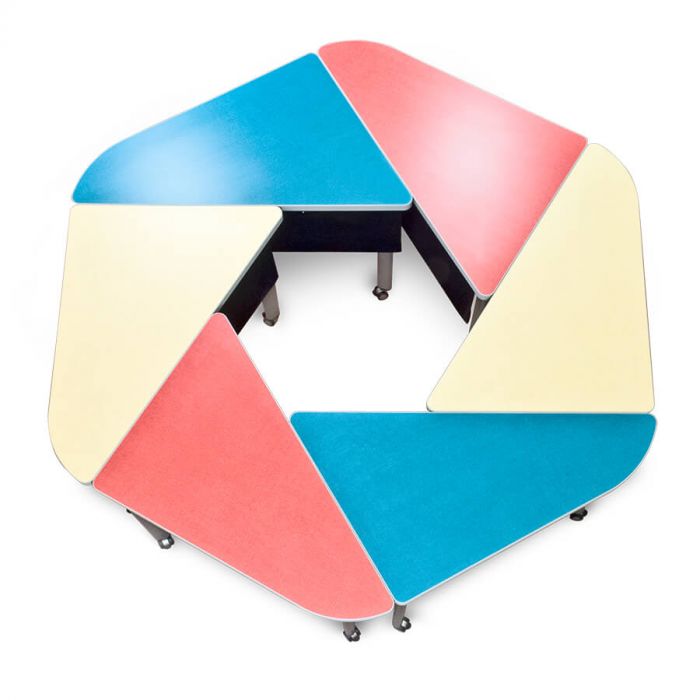
Conference rooms are rarely just for conferences. These large rooms are the heart of the office, where all the action happens. They host important decision-making meetings, employee birthdays, workshops, team-building events, interviews, video conferences, and so much more.
At the center of it all usually lies a conference table. While traditional conference tables can work well for meetings, they don’t always lend themselves to the many other activities that find their way into conference rooms. This is why modular conference tables are becoming so popular.
What Does “Modular Furniture” Mean?
Modular furniture can be subdivided into smaller parts (“modules”) that fit together in a variety of ways. Modules are typically designed to be interchangeable, and they can be used on their own or as part of a larger, customized piece of furniture.
Think of the modules as bricks. A single brick can function on its own in different ways, like as a doorstop or maybe a book end. If you combine multiple bricks, you can create something entirely new, like a fire pit or an entire house. Similarly, you can combine furniture modules to create a different piece of furniture, like a group meeting desk or long conference table.
What Is the Difference Between Modular Furniture and Normal Furniture?
Simply put, normal furniture lacks the flexibility and customization you get with modular furniture. To illustrate this point, imagine an office space with only one conference room. The company occupying the space uses this conference room for all their professional gatherings. Because the room serves many different purposes, the company decides to replace their old, normal conference table with a modular one.
Now, when the company has brainstorming sessions, they break apart the modules and put them back together in groups of three or four throughout the room. For board meetings, they bring the modules back together to form a single rectangular table. If they have presentations, they spread the modules out into a U-shape, with one module at the front for the presenter.
Because of the modular conference table, that company had the power to create customized solutions for their various needs. They weren’t forced to work around the conference table, and instead could make the modules work for them.
This flexibility is only one reason why modular furniture is important—there are numerous other advantages as well, especially for conference rooms.
What Are the Advantages of Modular Furniture in Conference Rooms?
Flexibility, sustainability, easy handling—the benefits of modular furniture make them appealing options for any space. Let’s take a look at these and other advantages for conference rooms specifically:
1. Flexibility – The needs of any office space will inevitably change over time. If you have modular conference room furniture, you have multiple arrangement and layout options to suit each unique scenario.
2. Customization – Modular furniture is customizable in two senses. First, it can be modified to support a particular individual or task, like pulling apart a long conference table to make individual work desks. Second, modular furniture is also usually customizable with the manufacturer for the exact specifications of your space. For example, SMARTdesks has integrated design services to customize modular furniture solutions for conference rooms, classrooms, and much more.
3. Sustainability – Flexibility and customization are what make modular furniture sustainable. Modular furniture, by design, is meant to be reused in different ways. So if your company grows, for example, and you need a bigger conference room, you could simply add more modules to your current modular conference table (versus replacing it and buying a whole new one).
4. Cost-Efficient – Right in line with sustainability comes cost efficiency. Having the option to rearrange your furniture to meet changing needs over time also means spending less on furniture over time. Using the same example from above, adding a few more modules to your conference table will undoubtedly cost less than an entirely new conference table.
5. Easy Handling – If you’ve ever had to move a traditional, larger conference table, you’ll appreciate the easy handling of modular conference tables. Instead of lugging a whole table, you can take apart each module and effortlessly move it where it needs to go.
6. Increased Employee Satisfaction – A survey by Future Workplace Academy, seeking insight on future workplace wellness and satisfaction, found that 42% of workers want the option to adjust their personal workspace conditions. Modular furniture is a great way to give employees personalization options, thereby increasing their workplace satisfaction.
What Is Modular Furniture Made Of?
Manufacturers make modular furniture out of many different materials, but you’ll want to look for materials that will endure regular use and rearranging. Sturdy materials that support modular furniture include:
● Steel – Steel is one of the strongest and most widely used metals in the world. It is commonly used in roads, appliances, skyscrapers, and even for reinforcing concrete. This makes it a prime choice for furniture, as it allows the furniture to support large amounts of weight. If you see modular furniture with steel in the base, legs, or some other supporting role, you can rest assured it will be sturdy.
● Engineered Wood – Engineered wood is made with real wood, scrap wood, shredded wood fibers, and/or sawdust. These materials are bound together with adhesives in such a way that it can look and act like real wood. Studies show that engineered wood offers high strength at a lower cost than traditional sawn lumber. Particle board, medium density fiberboard, and plywood are popular examples of engineered wood.
● Laminate – Laminate is made by pressing together layers of heavy-duty paper with the compound melamine, which hardens into a durable resin. It can be applied as a coating to engineered wood, providing a decorative finish with nearly any design or color you can imagine (like a bright pop of green or traditional woodgrain). Laminate is stain and scratch resistant, easy to clean, and generally a more affordable option when compared to other materials like wood or granite.
● Polyvinyl Chloride (PVC) – When you hear “PVC,” you might immediately think of the white PVC pipes used for drainage and plumbing. However, PVC is also used in modular furniture as an edge trim due to its flexible yet durable qualities. This allows manufacturers to create curved edges for modular furniture. And you likely already know why curved edges are so great—just think of the last time you accidentally bumped into a piece of furniture with a sharp edge.
What Are the Types of Modular Furniture for Conference Rooms?
Modular conference room furniture comes in many forms to suit varying needs. Here are three conference tables we get asked about frequently at SMARTdesks, and how you can make them modular.
1. What Is a Round Conference Table?
A round conference table is designed to facilitate discussion in an environment where everyone is considered equal. This idea is thought to stem from the legend of King Arthur’s “knights of the Round Table,” where knights sat in perfect equality and were served similarly. With a round table, there is no “head” to the table or obvious place where a leader would sit. This allows everyone at the table to feel involved and included in whatever discourse or meeting is taking place.
Round conference tables that are modular will not always be a perfect circle. This is partially because the modules of a perfect circle would have sharp corners, which isn’t ideal for furniture you plan to move around and use frequently. This Yin Yang Computer Table is a perfect example. You can see the pointed ends of each table are rounded, but the full effect is that of a circular table. And if you’d prefer an expandable conference table, adding in the Rio Extension Tables can give you a long, oval-shaped conference table with many other configuration options.
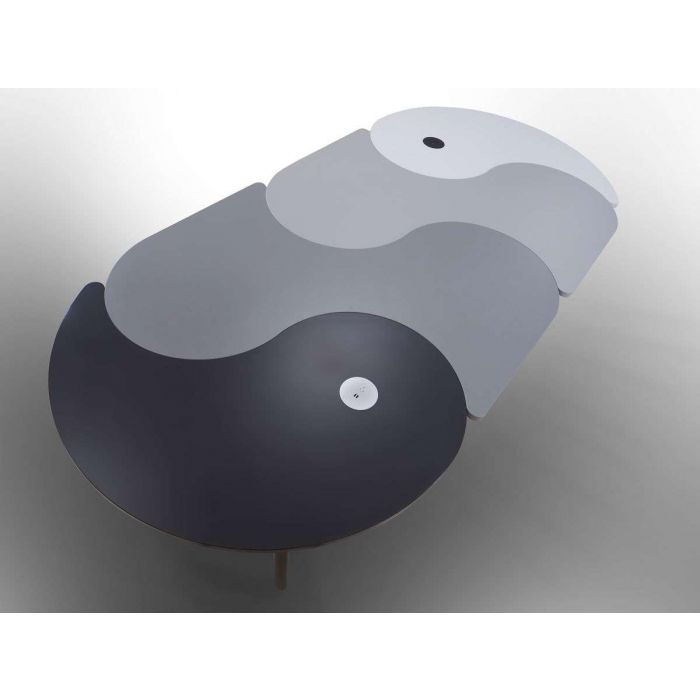
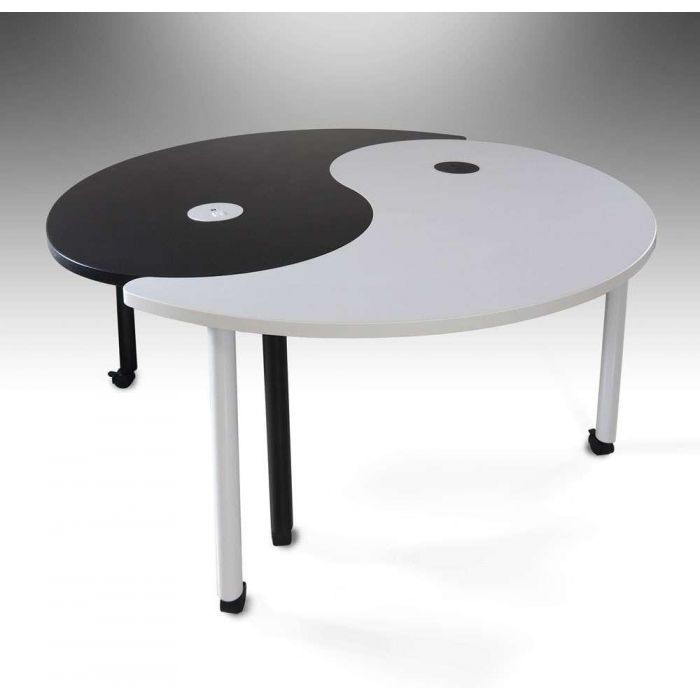
2. What Is a Boardroom Table?
A boardroom table is meant to host a company’s board of directors for regular meetings to strategize and oversee management. There is no one style of boardroom table or boardroom layout, as everyone will have different preferences.
Many companies with modular conference tables go with the hollow square layout, which involves lining up rectangular modules to form an open square. This kind of setup is similar to a round conference table in that there is no obvious place for a “head” of the meeting, which puts everyone on equal footing. However, unlike a round conference table, rectangular conference tables usually offer more seating options.
These Motif Computer Conference Modules would fully support a boardroom meeting of any size. They come in single and double workstation modules that can be easily configured in numerous shapes—hollow square, U-shape, face-to-face, or an open-ended arrangement.
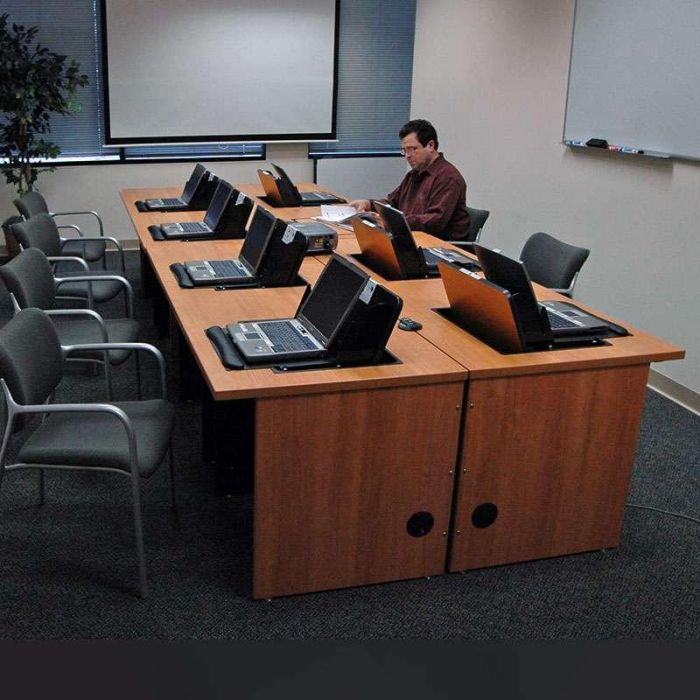
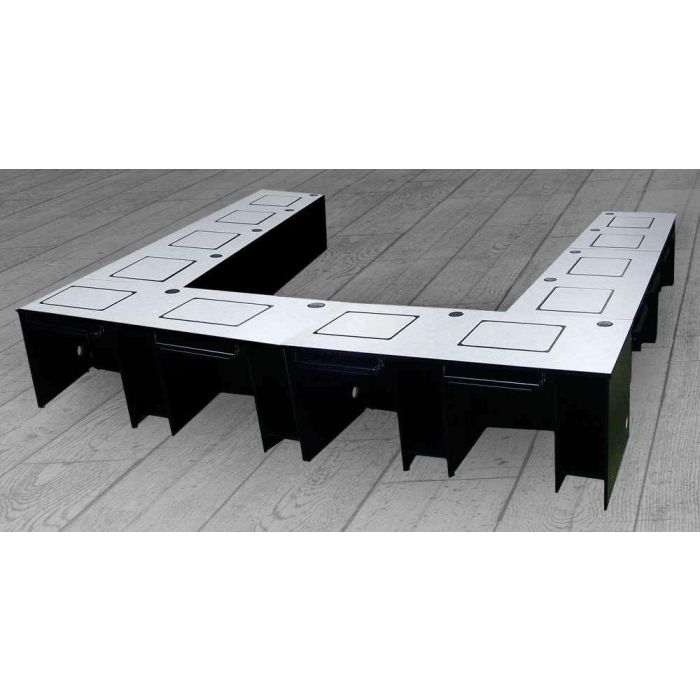
3. What Are Nesting Conference Tables?
Nesting conference tables fold up in such a way that they fit snugly together when being stored. These are ideal for multi-purpose rooms, as they can be easily tucked away when not in use. Many nesting conference tables also have power and data connectivity options, as conference meetings usually require having a laptop, tablet, or other electronic device on hand.
These kinds of tables are modular by nature, as they are designed to fit together in storage and when in use. You can see an excellent example below with the Nesta™ Flip Top Tables. They take up minimal space nested together, but provide a wide tabletop to work on when flipped down. The modular wiring system underneath each table moves power from one table to the next, meaning an entire row of people could share the same power plug.
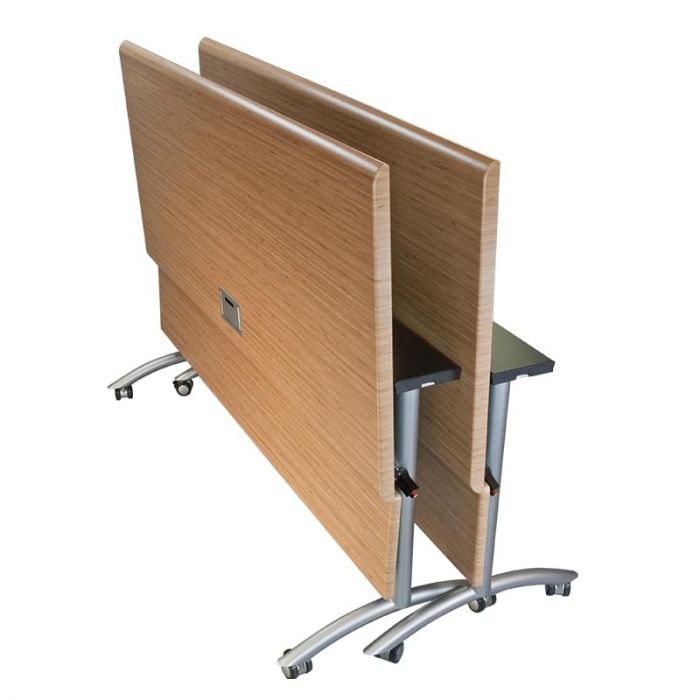
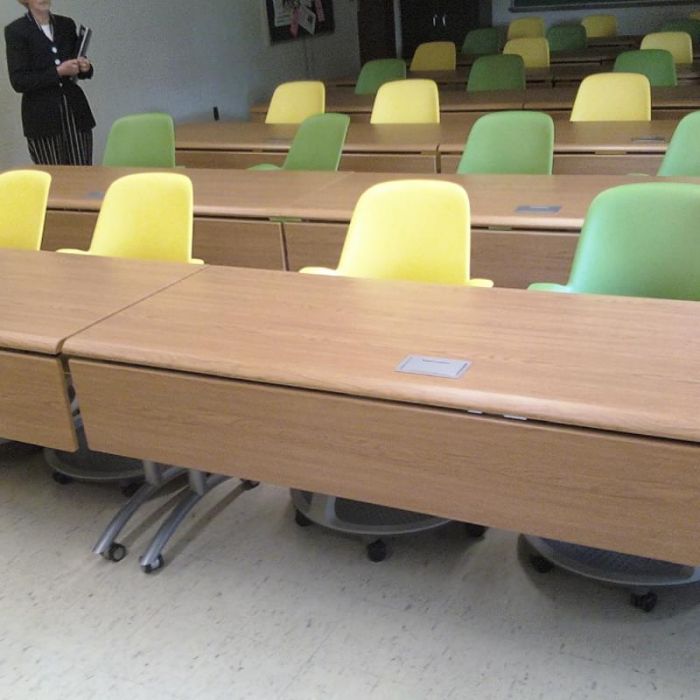
What Size Modular Conference Table Do I Need?
When considering the size of your conference table, you’ll want to consider two key factors:
1. The size of the space – It’s best to leave at least three feet between the edge of the conference table and the wall. This gives people enough room to walk to their place, pull their seat out, and sit down.
2. The average number of users – Each person seated at the table should have enough room to be comfortable. Leaving about two feet of space per person is a common rule of thumb, but allowing for more room can’t hurt.To give an example, here’s how long a rectangular, face-to-face style conference table should be for differing numbers of people:
● How long is a 10-person conference table?
A 10-person conference table would have five people per side. If each person needs at least two feet of space, then the minimum length of the table would have to be 10 feet.
● How long is a 14-person conference table?
With seven people per side, this conference table would need to be at least 14 feet long.
● How long is a 20-person conference table?
Ten people per side would require a minimum table length of at least 20 feet.
If you get a modular conference table, however, these answers can change. The modules allow you to choose a number of configurations to suit differing numbers of people. This is great for the day-to-day operations of a conference room, as well as for the future of your business. Think about it—as your business grows, you can simply get additional modules to accommodate more people.
Where Can I Find Modular Conference Tables for Sale?
SMARTdesks has a diverse selection of conference tables for sale, including many modular options. And we don’t simply sell modular conference tables—we also create customized modular table designs and layouts for our customers. We’ll consider your organization’s unique goals, budget, team, as well as your IT needs.
Browse our website to see what other table and desk options we have available, or send us a design request to get rolling on your project!

